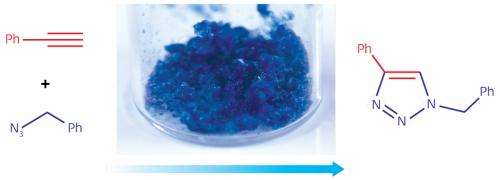Self-assembling polymeric copper catalyst greatly accelerates 'click reaction'

Few recently discovered chemical reactions have proven as powerful as the copper-catalysed Huisgen 1,3-dipolar cycloaddition between azides and alkynes—a transformation better known as a 'click reaction'. The process gets its nickname from the robust, reliable way that the azide and the alkyne organic functional groups 'click' together. From materials science to biochemical applications, this dependable method for joining molecules together has been exploited widely in the decade since its discovery. Now, Yoichi Yamada, Shaheen Sarkar and Yasuhiro Uozumi at the RIKEN Advanced Science Institute in Wako have developed a new form of heterogeneous copper catalyst that promises to make the click reaction more efficient than ever.
Heterogeneous catalysts do not dissolve into the reaction mixture; they remain as a solid inside the reaction flask, offering a catalytic surface on which the reaction can take place. The key advantage of these catalysts is that they can easily be recaptured for re-use at the end of a reaction, often by simple filtration. Their disadvantage is that they are less intimately dispersed with the reactants than catalysts that dissolve, slowing the reaction.
The researchers overcame this disadvantage by embedding their copper within a self-assembled two-component polymer. The polymer backbone is made of a material called isopropylacrylamide, which has a hydrophobic sub-section and a hydrophilic sub-section. Overall, the material acts as an 'amphiphilic sponge': it readily draws in reactants and substrates regardless of their hydrophobicity, Yamada says.
The second polymer component is an imidazole, an electron-donating material that stabilizes and activates the copper to accelerate the click reaction. "The catalytic copper species within the sponge instantaneously react with substrates and reactant to give the products and to regenerate the catalyst," Yamada explains.
The material's performance is the best yet reported for a heterogeneous click catalyst, he adds. The best previous materials had turnover numbers below 1,000 before the catalyst would become deactivated, whereas the team's catalyst had a turnover number of 209,000. The catalyst's turnover frequency was also fast, turning reactants into product at a rate of 6,740 conversions per hour.
The re-usable catalyst should find a host of applications, Yamada says. "The catalyst will be applied to the synthesis of pharmaceutical compounds and functional organic materials." The next step for the researchers is to incorporate the catalyst into a 'flow system', in which the catalyst is immobilized within a cartridge through which substrates and reagents are continually pumped, generating a continuous steady stream of product.
More information: Yamada, Y. M. A., Sarkar, S. M. & Uozumi, Y. Amphiphilic self-assembled polymeric copper catalyst to parts per million levels: click chemistry. Journal of the American Chemical Society 134, 9285–9290 (2012). dx.doi.org/10.1021/ja3036543
Journal information: Journal of the American Chemical Society
Provided by RIKEN



















